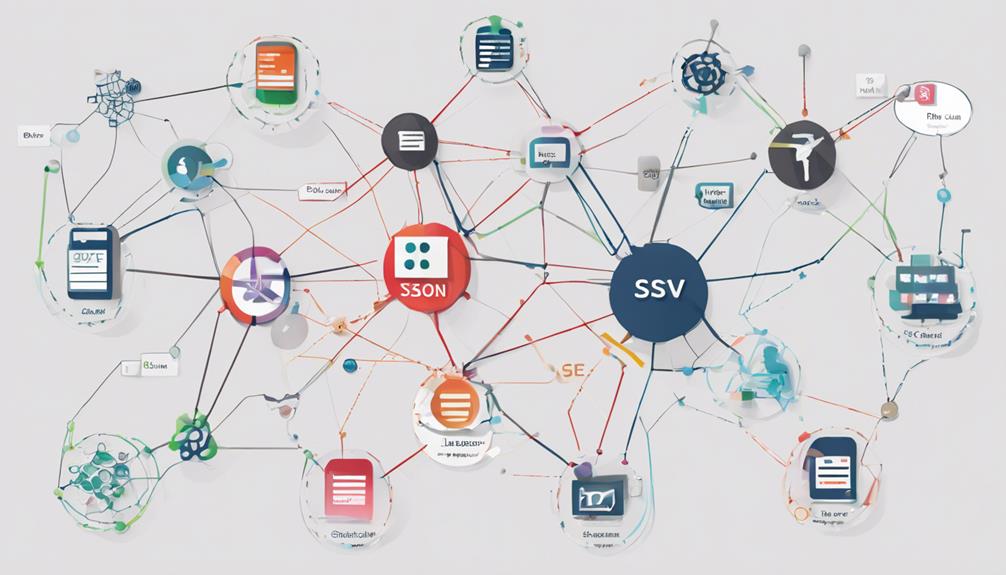You might think that database data formatting services are merely about tidying up information, but the truth is, the current trends are reshaping the landscape beyond recognition. From the seamless automation of routine tasks to the integration of cutting-edge AI technologies, the possibilities seem endless. As the industry evolves at a rapid pace, the question arises: what are the trends in database data formatting services and decision-making processes?
Automation in Data Formatting Services
Data formatting services have undergone a significant transformation with the integration of automation. The implementation of data processing automation has revolutionized the efficiency of formatting services. By automating repetitive tasks such as standardizing data formats, cleaning datasets, and structuring information, companies can now streamline their processes and reduce manual errors significantly.
Efficiency improvement is at the core of this automation trend. Manual data formatting is not only time-consuming but also prone to human error. With automation tools, tasks that used to take hours or even days can now be completed in a fraction of the time, leading to quicker delivery of formatted data. Moreover, automation ensures consistency in data formatting, reducing the likelihood of inconsistencies or inaccuracies in the processed information.
AI Integration for Data Formatting
AI integration in data formatting services offers significant benefits by enhancing automation and improving accuracy. By incorporating AI technologies, tasks such as data cleansing and standardization can be streamlined, leading to more efficient processes. The utilization of AI ensures a higher level of precision in data formatting, contributing to better overall data quality.
AI in Data Formatting
Within the realm of database data formatting services, the integration of artificial intelligence (AI) has emerged as a pivotal trend. AI plays a crucial role in data formatting through machine learning applications and advanced data cleaning techniques. Machine learning algorithms enable AI systems to learn from data patterns and make intelligent decisions regarding formatting requirements. These algorithms can automatically identify and rectify formatting errors, inconsistencies, and outliers within large datasets, significantly improving the accuracy and efficiency of data formatting processes.
AI’s data cleaning techniques involve identifying duplicate entries, standardizing data formats, and resolving discrepancies to ensure data integrity. By leveraging AI capabilities, organizations can streamline data formatting tasks, reduce manual errors, and enhance overall data quality. Furthermore, AI systems can adapt to evolving formatting requirements, making them valuable assets for dynamic databases that frequently update their structures.
Automation Benefits
Incorporating artificial intelligence into database data formatting services yields significant automation benefits. Efficiency improvement is a key advantage of AI integration, as it streamlines the data formatting process by automating repetitive tasks such as data categorization, standardization, and validation. This automation reduces the time and effort required for manual data formatting, allowing businesses to process large volumes of data more quickly and accurately.
Moreover, AI-driven automation in data formatting services also leads to cost reduction. By minimizing the need for manual intervention, organizations can lower labor costs associated with data formatting tasks. Additionally, the improved efficiency resulting from AI integration can enhance overall productivity and operational effectiveness.
Accuracy Enhancement
Enhancing data accuracy through the integration of artificial intelligence into data formatting processes is a critical aspect of modern database management. By incorporating AI algorithms for data validation and error detection, databases can ensure the integrity and reliability of their information. AI can analyze large volumes of data at high speeds, identifying inconsistencies, anomalies, and inaccuracies that might be missed by traditional methods. Through machine learning, AI systems can continuously improve their accuracy in detecting and correcting errors, leading to more precise and reliable databases.
Integrating AI into data formatting processes enables real-time error detection and automatic correction, reducing the likelihood of inaccuracies slipping through unnoticed. By leveraging AI algorithms for accuracy enhancement, database administrators can streamline their data management workflows, saving time and resources while maintaining data quality. The proactive approach of AI in error detection helps prevent data corruption and ensures that databases are consistently up-to-date and accurate.
Cloud-Based Solutions for Formatting Data
With the growing demand for efficient data management, utilizing cloud-based solutions for formatting data has emerged as a pivotal trend in the realm of database services. Cloud-based solutions offer enhanced data security through advanced encryption methods and secure access controls. This ensures that sensitive information is protected from unauthorized access or breaches. Moreover, these solutions provide cost efficiency by eliminating the need for extensive hardware investments and reducing maintenance costs. By leveraging cloud-based services, organizations can streamline their data formatting processes, leading to improved operational efficiency and scalability. Additionally, cloud solutions enable seamless collaboration among team members located in different geographical locations by providing centralized access to formatted data. Overall, the adoption of cloud-based solutions for formatting data not only enhances data security but also proves to be a cost-effective option for businesses looking to optimize their database management processes.
Real-Time Data Processing Trends
Amidst the evolving landscape of database management, staying abreast of real-time data processing trends is imperative for organizations seeking to optimize their data handling capabilities. Real-time data processing involves the ability to analyze and act on data instantaneously as it is generated. One key trend in real-time data processing is the integration of predictive analytics. By leveraging predictive analytics algorithms, organizations can anticipate future trends and behaviors based on historical data patterns, enabling proactive decision-making.
Another significant trend is the incorporation of machine learning into real-time data processing systems. Machine learning algorithms enable systems to automatically learn and improve from experience without being explicitly programmed. This capability enhances the efficiency and accuracy of real-time data processing tasks. Organizations that harness machine learning in their real-time data processing workflows can gain valuable insights from large volumes of data in a timely manner, leading to more informed decision-making and competitive advantages in today’s data-driven business landscape.
Enhancing Data Quality Management
Data quality management plays a pivotal role in ensuring the reliability and effectiveness of an organization’s database systems. To enhance data quality management, organizations are increasingly turning to data enrichment techniques and stringent quality control measures. Data enrichment involves augmenting existing data with additional information from external sources to improve its quality and usefulness. By enriching data, organizations can enhance their decision-making processes, gain deeper insights, and improve overall operational efficiency.
Quality control is another critical aspect of enhancing data quality management. Implementing robust quality control measures helps in detecting and rectifying errors, inconsistencies, and redundancies in the database. This ensures that the data stored is accurate, consistent, and up-to-date, thereby increasing its reliability for various business operations.
Evolving Data Governance Practices
As organizations continue to navigate the complexities of managing vast amounts of data, the evolution of data governance practices becomes increasingly crucial. Data governance evolution is essential for ensuring data quality, security, and compliance within organizations. With the rise of big data innovations and real-time analytics, the need for robust data governance practices has become even more pressing.
Effective data governance involves establishing clear policies, procedures, and controls to manage data assets systematically. It encompasses defining data ownership, establishing data quality standards, ensuring data security and privacy, and complying with regulations. Organizations must continuously adapt their data governance practices to keep pace with technological advancements, changing data landscapes, and evolving regulatory requirements.
Innovations in Big Data Processing
You must consider the significant advancements in big data processing, including the rise of real-time data analytics for immediate insights into vast datasets. Scalable cloud solutions have revolutionized how data is stored and processed, offering flexibility and efficiency in managing large volumes of information. Furthermore, AI-driven data processing techniques are transforming the way organizations extract valuable insights from complex data sets, enhancing decision-making processes.
Real-Time Data Analytics
With the exponential growth in data volumes being generated every second, real-time data analytics has become a critical component in understanding and leveraging big data processing. Real-time data analytics allows for streamlined analysis of data as it is generated, providing businesses with the ability to make immediate decisions based on up-to-date information. By harnessing real-time data analytics, organizations can gain predictive insights into trends, customer behaviors, and market dynamics, enabling proactive decision-making and staying ahead of the competition. This innovative approach to data processing empowers businesses to react swiftly to changing circumstances, optimize operations in real-time, and capitalize on emerging opportunities promptly. Leveraging real-time data analytics not only enhances operational efficiency but also enables businesses to provide personalized experiences to customers, leading to increased satisfaction and loyalty. In today’s fast-paced digital landscape, real-time data analytics is a game-changer in driving informed decision-making and achieving competitive advantage.
Scalable Cloud Solutions
In the realm of big data processing, scalable cloud solutions have emerged as a pivotal innovation that revolutionizes data management and analytics. These cloud solutions offer flexibility, efficiency, and scalability, making them indispensable for organizations dealing with vast amounts of data. Here are some key aspects to consider:
- Data Migration: Seamless transfer of data between different storage systems.
- Data Virtualization: Creating a layer of abstraction to access and manipulate data without worrying about its physical location.
- Scalability: Ability to rapidly expand or reduce resources based on demand.
- Cost-Effectiveness: Pay-as-you-go models that ensure you only pay for the resources you use.
- Global Accessibility: Access data from anywhere in the world, enabling collaboration and real-time decision-making.
Embracing scalable cloud solutions can significantly enhance your data processing capabilities, providing agility and efficiency in managing and analyzing large datasets.
Ai-Driven Data Processing
Ai-Driven Data Processing is at the forefront of innovations in big data management, leveraging artificial intelligence to streamline and enhance the processing of vast datasets. Machine learning algorithms play a crucial role in automating data transformation processes, enabling organizations to extract valuable insights efficiently. Through advanced data processing techniques, AI can sift through massive amounts of information swiftly and accurately, identifying patterns and trends that might otherwise go unnoticed.
Frequently Asked Questions
How Can Data Formatting Services Help With Compliance Regulations?
Data formatting services ensure compliance with data privacy regulations. They streamline processes, automating data handling to meet regulatory requirements efficiently. By utilizing these services, you can enhance your data management practices and avoid penalties for non-compliance.
What Are the Key Considerations When Selecting a Data Formatting Provider?
When choosing a data formatting provider, prioritize cost effectiveness and customer support. Ensure scalability and customization options align with your needs. Consider how well the provider’s capabilities match your requirements for efficient and effective data management.
Can Data Formatting Services Handle Unstructured Data Effectively?
Yes, data formatting services can effectively handle unstructured data by utilizing natural language processing techniques and machine learning algorithms. These advanced technologies enable the services to interpret and structure unorganized information accurately and efficiently.
What Are the Security Measures in Place for Formatted Data?
To protect formatted data, implement robust security measures. Utilize data encryption to safeguard information during transmission and storage. Set up access control mechanisms to restrict unauthorized entry. These practices ensure data integrity and confidentiality.
How Do Data Formatting Services Assist With Data Migration Projects?
Data formatting services aid in data migration projects by conducting data cleansing and validation to ensure accuracy. Additionally, they facilitate data transformation and normalization, streamlining the process for seamless migration of data across systems.



